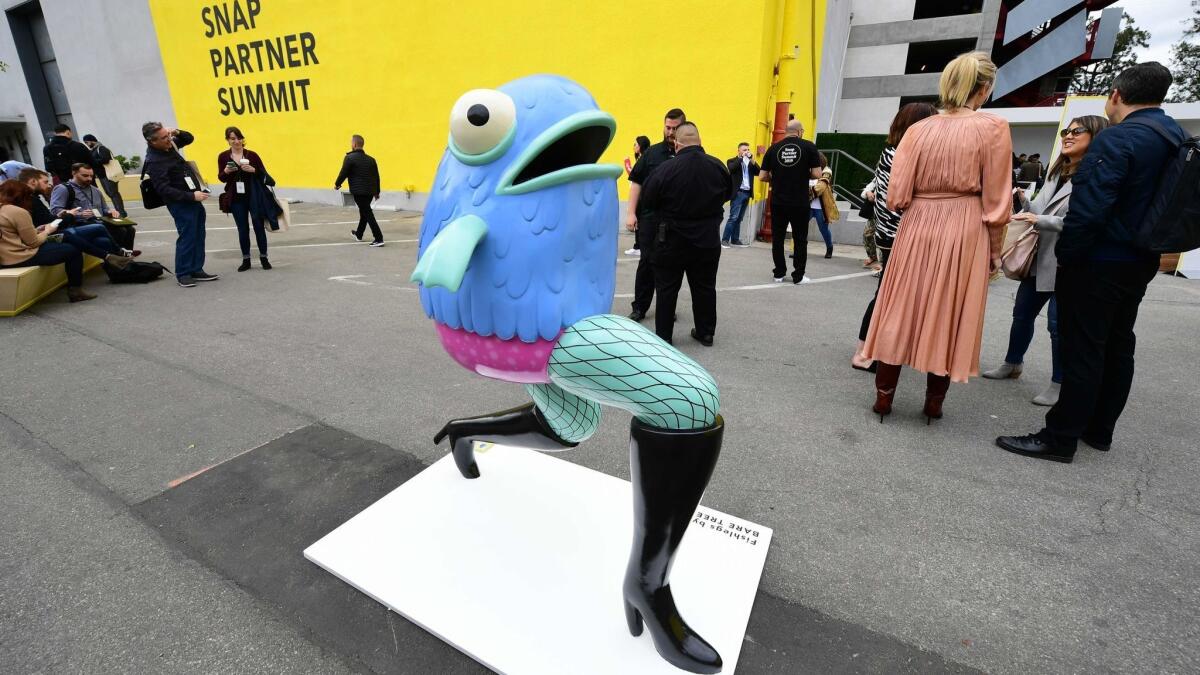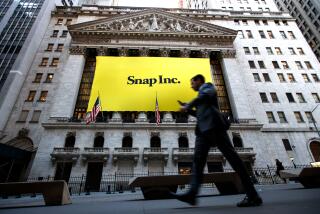Snap has three years to make a profit before it runs out of money

- Share via
In spring 2017, global markets crowned Evan Spiegel the new boy king of tech. At just 26 years old, Spiegel took his photo-message and camera company Snap Inc. public for $24 billion, making it the biggest initial public offering in years. The unprofitable company was valued more highly than Facebook Inc., with a market capitalization nearly 60 times bigger than sales. By the end of the year, stock-based awards made Spiegel the highest-paid chief executive in the United States.
Two years on, Snap has suffered an executive exodus including two chief financial officers, the chief strategy officer and the head of human resources. After a disastrous redesign of the company’s signature Snapchat app, user numbers stopped growing. Shares now trade 30% below the listing price.
The Santa Monica social media company has gone from scrappy start-up to multibillion-dollar public stock to plotting its own recovery in the space of just eight years. The compressed timeline illustrates the late stage of Silicon Valley’s current investment cycle.
This year is expected to set a record for tech IPOs — including ride-hailing companies Lyft and Uber and messaging-app firm Slack — in terms of money raised and the size of listings. Like Snap, most are not yet profitable. All hope to be valued at large multiples of sales. But Snap’s experience over the last two years suggests their finances may be judged more harshly once they swap the Silicon Valley bubble for public life.
Spiegel promises Snap will have a turnaround this year. User numbers have steadied, and the share price is rising. Problems at larger rival Facebook could present an opportunity. But the clock is ticking. According to a Financial Times analysis, the company has just over three years to become cash flow-neutral before it will need to raise fresh funds. In that time, Snap must raise user numbers and cut costs while fighting off Facebook’s plan to neutralize all and any competition.
Facebook has taken so much oxygen that everyone else is having trouble breathing.
— Aswath Damodaran, New York University finance professor
From the beginning, Spiegel’s fortunes have been entwined with those of Facebook. His pedigree as an elite college dropout allied with a hit social media idea echoes Facebook Chief Executive Mark Zuckerberg’s almost perfectly.
Snap’s smartphone-designed, camera-centric messaging app Snapchat gained popularity in 2012 and made Facebook look old-fashioned. Teenagers flocked to the new network, delighted that their parents did not understand how it worked. By 2013, about 400 million photos and videos per day were being sent via Snapchat — more than the number shared on Facebook-owned Instagram. Brands and media companies including Starbucks, CNN and BuzzFeed were lining up to sign deals.
Facebook’s response was to try to buy the upstart. When rebuffed, it swiped Snapchat’s most creative features, including cute, animal-ear selfie filters and collections of disappearing pictures and videos called Stories, and put those features on Instagram. The cut-and-paste job was shameless. But it was legal and effective. Instagram Stories now has more users than Snapchat.
Snapchat is still popular. More than 186 million people use it each day — 60 million more than use Twitter. Although its user numbers are high, they have declined. This is a bigger impediment to a steep valuation than financial losses. About 5 million people have stopped using the app since last year, all but destroying the notion that Snap is a Facebook-killer. While Facebook’s market value has grown to the equivalent of more than $250 per user, Snap’s is less than $90.
“Facebook has taken so much oxygen that everyone else is having trouble breathing,” said Aswath Damodaran, a finance professor at New York University. “Snapchat is still attuned to a certain young demographic — it was the first video social media company. But it now needs to ... find its niche and survive.”
Too fast in some ways, too slow in others
When Snap had its IPO, there were plenty of jokes about the uncanny similarities between a company that created self-destructing messages and the risks involved in investing in a loss-making organization with few assets. The revenue multiple it sought was higher than Twitter’s or Facebook’s had been when they listed, and it was losing more money. Its founders retained near-total control by selling only shares with no voting rights.
Yet the chance to buy into a new social media platform encouraged investors to throw caution to the wind. On the first day of trading, the stock rose 44%.
In many ways Snap looks like a good bet. Social media networks are still growing. China’s WeChat, developed by Tencent, has more than 1 billion monthly users. Google-owned YouTube has close to 2 billion. Facebook has more than 2 billion monthly users across all its platforms. The success has encouraged new entrants such as video platform TikTok.
Like other social media companies, Snap makes most of its money by selling ads. And digital advertising is booming. This year, the market will exceed traditional ad spending in the United States for the first time, according to EMarketer. By 2020 it is estimated to reach $150 billion. Even better, Snap brims with so many ideas that it tends to make its competitors look slow and tired. Features such as augmented-reality rainbow-vomiting clouds painted over videos and photos were an instant hit.
The problem is that not every idea is a winner. Spiegel’s decision to change how users follow celebrities and message friends in 2017 prompted backlash from celebrities such as Kylie Jenner and regular users. “I hated the redesign,” said Cara Beckford, one of an estimated 14 million people in Britain who use Snapchat. “So did everyone I know.”
Snap declined to comment for this article, but in an interview last year, Spiegel said his company’s mistake was moving too fast for its audience to keep up.
Yet in another key part of product development, Snap has been too slow. Spiegel promised users and investors an overhaul of its Android app — which had been neglected as Snap prioritized iPhone owners — in 2017. The update is vital if Snapchat is to broaden its appeal outside the United States, where Apple has a far larger market share than in most of the rest of the world. But after prolonged delays, the full rollout will be completed only by the end of 2019.
97% of voting rights
Unlike Facebook and Twitter, Snap still runs at a loss — $192 million in the last quarter, and $1.3 billion in 2018. Both are an improvement on the previous year. But the cash the company has on hand has dwindled to about $1.3 billion, and Snap will struggle to raise fresh investor funds while its user count is down.
“Arguably Snap listed years too soon,” said Michael Nathanson of research company Moffett Nathanson. “And it did not raise enough capital when it went public or take out cheap convertible debt so that it would have the proceeds on hand when it needed them. Now it’s too late. No one will buy convertible debt unless they think the stock price is rising, and that is too uncertain.”
The control wielded by Spiegel and co-founder Bobby Murphy has made some uneasy. The pair hold roughly 97% of voting rights, up from 88.5% at the time Snap listed. That is largely because early investors with voting rights switched to non-voting shares in order to sell them.
Without recourse to votes, the majority of investors have no say in the company’s direction. That means Snap’s decision to cover the costs of operating an aircraft owned by Spiegel is not up for discussion. The perk is not uncommon for executives of large companies. But it is a questionable luxury at a business with negative operating cash flow.
Snap shares’ rapid and sustained fall since the IPO has deterred other tech founders from trying to claim similar voting rights, said Anne Sheehan, chair of the Securities and Exchange Commission’s Investor Advisory Committee. Lyft opted for dual class shares, but its founders did not seek the same level of control. “I think even if the stock had performed well, [Snap’s] share class arrangement would be a one-off,” she said. “Snap pushed the issue over the edge.”
The stock has begun to recover in recent months with Snap tightening its grip on finances — a shift credited to Chief Financial Officer Tim Stone, who joined the company last year. But some costs cannot be cut. Snap expanded quickly by using external servers from Google and Amazon Web Services. This cost increases as it grows more ambitious and gains more users. Hosting costs were 70 cents per user in 2018 — up from 60 cents the previous year. But negative operating cash flow also improved, by $50 million in the last quarter, amid job cuts.
Snap has lowered barriers for advertisers, moving from a direct-sales ad team to an automated platform, and cut prices. Even as user numbers have stalled, revenue — at $1.2 billion in 2018 — has risen. And there are more advertisers to attract. In the United States, Snapchat reaches more 13- to 24-year-olds than its rival Instagram, yet only a quarter of marketers use Snap while two-thirds use Instagram.
Since Snap’s IPO, its average monthly cash burn — the rate at which costs exceed money generated — has been $68 million. If it can maintain last quarter’s tight cost controls, then the burn can slow to $33 million a month, giving Snap more than three years to raise user numbers before it needs new funds. By that point it may be profitable. If not, the company should take a leaf out of Tesla’s book and consider issuing convertible debt, which carries lower interest rates than plain-vanilla bonds.
Capturing imaginations
To raise user numbers Snap needs old people. In social media terms, that’s anyone older than 35. They may be less proficient at taking selfies but they do tend to be loyal to the platforms they adopt and appreciate the privacy afforded by Snapchat’s disappearing messages.
Focusing on that goal would require a financial discipline the company has only just begun to demonstrate and one that runs counter to some of Snap’s grander ambitions. In January, Stone announced he was leaving the company after just eight months. The concern is whether this will give the founders free rein to spend more.
Snap trades at about $12 a share, which means that its market value is 13 times trailing revenue — far lower than it was at its IPO. But it still trades at a higher multiple than Twitter, which has similar revenue growth but is profitable. This suggests investors are betting on Snap soon becoming profitable or revealing a new idea.
Yet it has been a while since Snap dreamed up an idea that captured its users’ imaginations. A move into gaming and extra original content, announced this month, should help engagement and appeal to advertisers. But Snap is up against big spenders with similar plans at Facebook, Apple and Alphabet, Google’s parent company.
In the longer term, Snap’s big bet is the rise of augmented reality and the end of smartphones. Its camera-toting smartglasses, Spectacles, sold poorly and required a nearly $40-million write-down of unsold inventory in 2017. Undeterred, Snap has released a second iteration.
“We really see a future — it’s probably going to be more than a decade — but computing will stop being confined by a little screen and will be overlaid on the world,” Spiegel said last year. “At that point we’ll have had years and years of learning and iteration [from people buying and using Spectacles] that is very, very hard to replicate. That core understanding of the product is the differentiator.”
Yet smartglasses are still a niche product — too clumsy to be cool and lacking features that would make a phone obsolete. At the same time, Snap is being outplayed in its main business by Facebook, which has announced that it plans to focus on private conversations.
Cutting costs and rejiggering advertising mean Snap has escaped immediate danger. But it is too small to counteract Facebook’s enormous economies of scale. Snap can coexist with the world’s largest social network, but Zuckerberg’s business generates almost as much in annual free cash flow as Snap’s entire market capitalization. Snap has a little over three years to settle its business and turn a profit before it runs out of cash. Facebook can inflict plenty of damage before then.
© The Financial Times Limited 2019. All Rights Reserved. FT and Financial Times are trademarks of the Financial Times Ltd. Not to be redistributed, copied or modified in any way.






